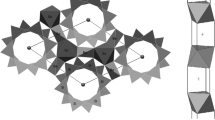Abstract
57Fe Mössbauer spectra obtained at room temperature and 78 K for natural Mg-saturated, Ca-saturated, and benzidinium-intercalated vermiculite having a high tetrahedral iron content are presented. For all samples the spectra were computer-fitted with five overlapping doublets, representing Fe in both tetrahedral and octahedral sites. One doublet has parameters consistent with the weathered ilmenite known to be present as inclusions. For the intercalated vermiculite, the δ value of the doublet assigned to the tetrahedral Fe3+ increased with respect to the untreated sample, suggesting that the electron densities about the Fe sites had decreased following intercalation. A charge movement from the silicate layers towards the interlayer monovalent benzidinium ions is also implied. The direction of this charge movement is opposite to that found when blue monopositive radical cations form on montmorillonite surfaces. The Mössbauer evidence suggests the absence of an interlayer-Fe3+ complex.
Similar content being viewed by others
References
Annersten, H. and Olesch, M. (1978) Distribution of ferrous and ferric iron in clintonite and the Mössbauer characteristics of ferric iron in tetrahedral co-ordination: Can. Mineral. 16, 199–203.
Cardile, C. M. and Johnston, J. H. (1985) Structural studies of nontronites with different iron contents by 57Fe Mössbauer spectroscopy: Clays & Clay Minerals 33, 295–300.
Cardile, C. M. and Johnston, J. H. (1986) A 57Fe Mössbauer spectroscopic study of montmorillonites: A new interpretation: Clays & Clay Minerals 34, 307–313.
Coey, J. M. D. (1980) Clay minerals and their transformations studied with nuclear techniques: The contribution of Mössbauer spectroscopy: At. Energy Rev. 18, 73–124.
Ericsson, T., Linares, J., and Lotse, E. (1984) A Mössbauer study of dithionite/citrate/bicarbonate treatment on a Vermiculite, a smectite and a soil: Clay Miner. 19, 85–91.
Ericsson, T., Wäppling, R., and Punakivi, K. (1977) Mössbauer spectroscopy applied to clay and related minerals: Geol. Fören. Förhandl. 99, 229–244.
Gibb, T. C., Greenwood, N. N., and Twist, W. (1969) The Mössbauer spectra of natural ilmenites: J. Inorg. Nucl. Chem. 31, 947–954.
Goodman, B. A. and Wilson, M. J. (1973) A study of the weathering of a biotite using the Mössbauer effect: Mineral. Mag. 39, 448–454.
Heller-Kallai, L. and Rozenson, I. (1981) The use of Mössbauer spectroscopy of iron in clay mineralogy: Phys. Chem. Minerals 7, 223–238.
Johnston, J. H. and Cardile, C. M. (1985) Iron sites in nontronite and the effect of interlayer cations from Mössbauer spectra: Clays & Clay Minerals 33, 21–30.
Johnston, J. H. and Cardile, C. M. (1987) Iron substitution in montmorillonite, illite, and glauconite by 57Fe Mössbauer spectroscopy: Clays & Clay Minerals 35, 170–176.
Johnston, J. H. and Lewis, D. G. (1986) A study of the initially formed hydrolysis species and intermediate polymers and their role in determining the product iron oxides formed in the weathering of iron: in Proc. Conf. on Industrial Applications of the Mössbauer Effect, Honolulu, Hawaii, 1984, G. J. Long and J. G. Stephens, eds., Plenum Publishing Co., New York (in press).
Norrish, K. (1973) Factors in the weathering of mica to vermiculite: in Proc. Int. Clay Conf, Madrid, 1972, J. M. Serratoza, ed., Div. Ciencias, C.S.I.C., Madrid, 417–432.
Rozenson, I. and Heller-Kallai, L. (1977) Mössbauer spectra of dioctahedral smectites: Clays & Clay Minerals 25, 94–101.
Slade, P. G. and Raupach, M. (1982) Structural model for benzidine-vermiculite: Clays & Clay Minerals 30, 297–305.
Taylor, G. L., Ruotsala, A. P., and Keeling, R. O. (1968) Analysis of iron in layer silicates by Mössbauer spectroscopy: Clays & Clay Minerals 16, 381–391.
Tennakoon, D. T. P., Thomas, J. M., and Tricker, M. J. (1974) Surface and intercalate chemistry of layered silicates. Pt. II. An iron-57 Mössbauer study of the role of lattice-substituted iron in the benzidine blue reaction of montmorillonite: J. Chem. Soc. Dalton Trans. 20, 2211–2215.
Tsipursky, S. I. and Drits, V. A. (1984) The distribution of octahedral cations in the 2:1 layers of dioctahedral smectites studied by oblique-texture electron diffraction: Clay Miner. 19, 177–193.
Author information
Authors and Affiliations
Rights and permissions
About this article
Cite this article
Cardile, C.M., Slade, P.G. Structural Study of a Benzidine-Vermiculite Intercalate Having a High Tetrahedral-Iron Content by 57Fe Mössbauer Spectroscopy. Clays Clay Miner. 35, 203–207 (1987). https://doi.org/10.1346/CCMN.1987.0350306
Received:
Accepted:
Published:
Issue Date:
DOI: https://doi.org/10.1346/CCMN.1987.0350306



